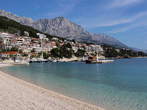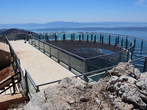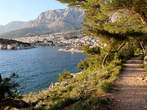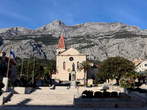Podgora is a small tourist and fishing village located in the very center of the Makarska Riviera and is considered the most beautiful place in the area. It lies southeast of Makarska on the road Split - Dubrovnik. It belongs to the Split-Dalmatia County.
The town is divided into two parts, Upper (Old) Podgora and Lower Podgora. It was first mentioned in written sources in 1571 as one of the cities under the protection of Venice after the Turkish defeat in the Battle of Lepanto. Tombstones from that time can be seen in the cemetery near the church of St. Tekla. The name Podgora comes from its location near the slopes of Biokovo. The city was one of the main strategic defense points to ward off Turkish incursions, so they built many towers. Upper Podgora was built by the locals when they were fleeing from numerous attacks on the slopes of Biokovo. Upper Podgora was formed in 1962, when an earthquake destroyed a large part of the city and many natural beauties. After the construction of the city, the rapid development of tourism in this area began. The largest local attractions are the famous monument Seagull wing and the sculpture Uzorita, which stands in front of the Hotel Mediteran. The sculpture represents a statue of a mermaid on a nearby rock in the water and is illuminated at night. The monument Seagull wing was erected in memory of the Partisan Navy, which was founded during the Second World War in 1942. It stands on the promontory of Cape Tekla, on the slope of Biokovo. The over 20-meter-high monument is a work of art by architect Rajko Radovic and represents a famous monument commemorating the war of national liberation. Near the monument is the prehistoric site of Three Graves, which served as guardhouses. Three graves are partially preserved, while the fourth has been excavated and remains of the grave are visible.
The ruins of the Roscic tower can be seen in Upper Podgora. The towers were part of a defense system that was built in the 18th and 19th centuries to defend against the Turks. The last surviving tower was badly damaged in the 1962 earthquake. The city is characterized by a long Christian tradition, as evidenced by the large number of churches and chapels. Important historical and cultural attractions include the following: the Church of All Saints, the octagonal Chapel of Sacred Heart of Jesus, the church of St. Roko with a cemetery from the 17th century, a medieval cemetery with the church of St. Tekla on Cape Tekla and the chapel - the Ijak lighthouse, which was once a functioning lighthouse. There are many springs of fresh water in the wider area of Podgora, and many of them are walled and beautifully landscaped. Podgora is known for its many beautiful beaches, which boast a crystal blue sea and a clean environment. The beaches in Podgorje stretch over about 6 kilometers of coastline. The most famous beaches are Centre beach, Plisivac beach, Dracevac beach, Garma beach, Sutikla beach and Caklje beach. The city is ideal for fans of sports activities, as there are many sports fields, cycling paths and a range of water sports available. Many hotels are available for visitors to stay in (Hotel Podgorka, Hotel Primordia, Hotel Aurora, Hotel Salines...), the Sutikla camp and private accommodations. During the summer, the locals organize many events, such as fishing nights, plays and musicals, music concerts, folklore shows, exhibitions and theater performances for the youngest.
Podgora is famous for its Mediterranean specialties, including fish, seafood, sheep's cheese, lamb, red wine and other culinary delights. Guests can choose from many restaurants, taverns and pizzerias.













 from 88.4 €
from 88.4 €